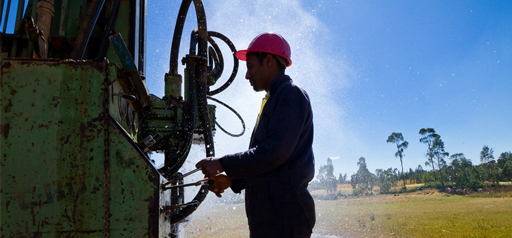9.2 Keeping a water treatment plant operational
The primary responsibility for a water utility is to provide a safe and adequate water supply to the users. From previous study sessions, you have learned about the need for a source of water that is reliable and can provide a sufficient quantity of water to meet demand. You also learned about the need to protect water sources and ensure they are not contaminated by pollutants of any type. Where water treatment is required, the water utility is responsible for keeping the water treatment plant running effectively and efficiently. An important part of this is the operation and maintenance procedures (Figure 9.3) that you learned about in Study Session 6.
What are the two types of maintenance required in water treatment works? Why is one better than the other?
The two types of maintenance are preventive maintenance and breakdown maintenance. Preventive maintenance involves regular checks that everything is working properly. Breakdown maintenance is needed if equipment breaks down. Preventive maintenance is the better approach because it avoids any break in supply, and is usually cheaper.

Knowing about the costs of running a water treatment works is a very important part of management. Like any organisation, sound financial management is a key responsibility for the utility. Costs include initial funding to construct the plant and buy the necessary equipment for the treatment processes. Recurring costs include the cost of the staff, power, consumables such as chemicals, and spare parts, repairs and replacement machinery required for maintenance of the plant. In Study Session 6 you also read about the assets of a water supply system and the need for an asset register.
Name three items you would expect to see included in the asset register of a water utility.
You could have answered with any of the items you would expect to see at a water treatment plant or in other parts of the water supply system. This could include the river intakes, surface water reservoirs, boreholes, all the associated pipework and pumps, process units, buildings (offices, plant rooms, etc.), office equipment (computers, office furniture, etc.), laboratories and analytical equipment, vehicles, pumping stations, water mains, and more!
Looking after all the assets is an important responsibility for water utilities; this is known as asset management. Asset management is the systematic process of deploying, operating, maintaining and upgrading facilities cost-effectively, and at the same time providing the best possible service to users. Asset management also ensures that financial resources are available to repair and replace equipment when necessary.
Asset management consists of the following five steps:
- Preparing an asset register.Knowing what assets you have and what their condition is.
- Prioritising your assets. In case you have a limited budget, prioritising helps you to allocate funds to the rehabilitation or replacement of your most important assets.
- Developing an asset management plan. Devising a plan to ensure continuous service delivery, and estimating the amount of money required to do this.
- Implementing your asset management plan. Working with the support of management to carry out the plan, ensuring that the technical and financial means to deliver safe water to your customers are available.
- Reviewing and revising your asset management plan. Your asset management plan should be reviewed regularly because with time the assets will change (for example, due to expansion of treatment plants, or an increase in the coverage of water distribution systems). The plan then has to be revised as necessary.
Unfortunately, even with an excellent asset management plan in place and effective preventive maintenance, the water utility may still find its customers are not always happy and may make complaints. This is the subject of the next section.
9.1.9 Independence
